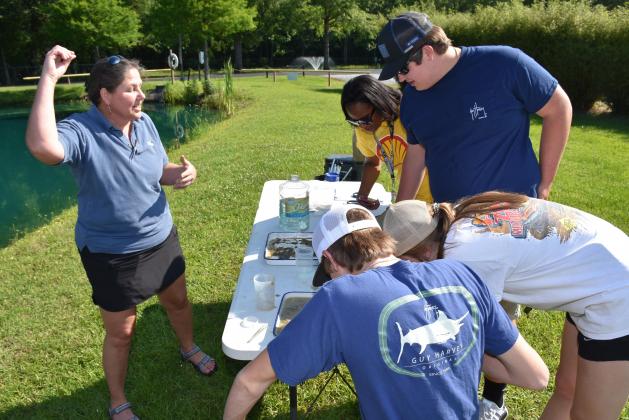
By Johnny Morgan, jmorgan@agcenter.lsu.edu
ROBERT — Tangipahoa Parish 4-H members were taught lessons in wetlands ecology recently at the Shell Training Center near Hammond.
The goal of the pilot program is to teach the students more about wetlands and the importance of the marsh and coastal areas.
The Shell Wetland Education Program develops and nurtures youth stewardship of natural Louisiana landscapes, said LSU AgCenter 4-H agent Joanna Pesson.
During the training, the students visited three stations where they were taught about different aquatic animal life and the roles they play in the ecosystem.
They also were shown how to do Geographic Information Systems mapping, how to determine the amount of lumber in a tree and they studied water quality.
Carol Franze, an AgCenter and Louisiana Sea Grant specialist, discussed the many aquatic animals that live in pond water at the training center.
“This is really a revamp of the Shell Youth Wetlands Program that we started here around 2009,” Franze said. “We wanted to give the program a more defined educational purpose.”
Brian LeBlanc, an AgCenter watershed management and water quality specialist, took water samples from the pond at the center.
“What I’ve found is some of these students have a really good understanding of wetland ecology,” he said.
AgCenter 4-H agents Pesson, Meghan Roberts and Jessie Hoover, along with AgCenter forestry and wildlife agent Whitney Wallace, provided information to help the students understand the importance of wetlands to Louisiana.
Fran Harvey, a GIS mapping professional, showed the students how to use and apply mapping tools.
“We’re teaching the students how to use GIS and explaining to them why it’s important to do mapping and to be aware of your surroundings,” she said.
Hoover said the students are learning some forestry skills that shows them how to estimate the amount of lumber in a tree.
Roberts said the training for the Tangipahoa Parish students are undergoing is a pilot program they hope to expand to the state. The students range from sixth through 12th grade.
Paris Jernigan, an eighth-grade student from Ponchatoula Junior High School, said the lessons were a lot of fun and informative.
“I learned that purple martins are the only martins in North America, and finding the invertebrates in the water samples was the most fun here today,” she said.
Pesson said the kids loved the experience.
“From the four lesson topics that were discussed throughout the day, the 4-Hers seemed to enjoy the GIS mapping and collecting the benthic invertebrates and identifying the different species,” she said.
The students also enjoyed learning how to identify trees and determining whether the trees had damage.
“Most of the 4-Hers stated that the water quality measurement session needed to be more hands on,” Pesson said. “The older 4-Hers were more impressed with that lesson than the younger ones.”
Pesson said this was a pilot program with the 4-H junior leaders in order to work on a similar program in the fall and spring for sixth to eighth graders.
Greg Byers, with the Shell Oil Company, said the center in Robert is a 35-acre operations training facility.
“We train operations staff as well as our technical staff in all aspects of their job performance in the Gulf of Mexico,” said Byers, a health, safety, security and environmental learning advisor. “Anything that any worker needs to be effective at their job or safe at their job, they can get it here.”
The Shell Training Facility has a learning base of about 3,000 people per month for trainings, seminars and conferences, he said.
